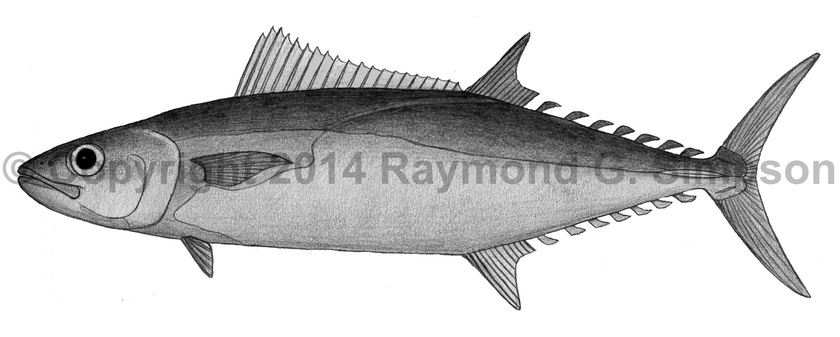
Common Name
Slender Tuna
Year Described
Serventy, 1948
Identification
Dorsal Fin: XV-XVIII, 12-13, followed by 7 finlets
Anal Fin: 13-14, followed by 6-7 finlets
Pectoral Fin: 25-28
Gill Rakers: 70-80
Vertebrae: 39
Body fusiform, elongate, and oval in cross-section. Snout about twice eye diameter. Adipose eyelid absent. Jaw extends to middle of orbit. Teeth small and conical. Two interpelvic processes; shorter than pelvic fins. Dorsal fins separated by a very small gap. Spiny dorsal fin long, with a strongly concave margin. Second dorsal and anal fin small with tall anterior lobes. Pectoral fins short. Caudal fin semilunate. Corselet well developed. Body with small scales dorsally. Two small caudal keels with a larger median keel in between them.
Color
Body unmarked silvery blue on the flanks grading to dark blue-black on the back. Belly white. Pectoral, caudal, and dorsal fins dark. Anal and pelvic fins pale.
Size
Maximum size to 105cm FL. Common to 85cm FL.
Habitat
Epipelagic in oceanic waters. Migrates between lower latitudes and colder sub-Antarctic waters. Forms schools.
Range
Southwestern Atlantic: S. Brazil to Argentina. Rarely encountered.
References
Amorim, A.F., A.A. Largacha and M.M.B. Gonzalez. 2011. Occurrence of Slender Tuna (Allothunnus fallai) off Sao Paulo State, Brazil. Collect. Vol. Sci. Pap. ICCAT, 66(5): 2134-2139.
Collette, B.B. and Nauen, C.E. 1983. Scombrids of the world. An annotated and illustrated catalogue of tunas, mackerels, bonitos and related species known to date. FAO species catalogue Vol. 2. , Source: FAO Fish. Synop. Vol. 125. 137pp.
Collette, B.B. and Diaz de Astarloa, J.M. 2008. Southernmost occurrence of the slender tuna, Allothunnus fallai, off Tierra del Fuego, South Atlantic Ocean. Ichthyological Research 55(1): 95-96.